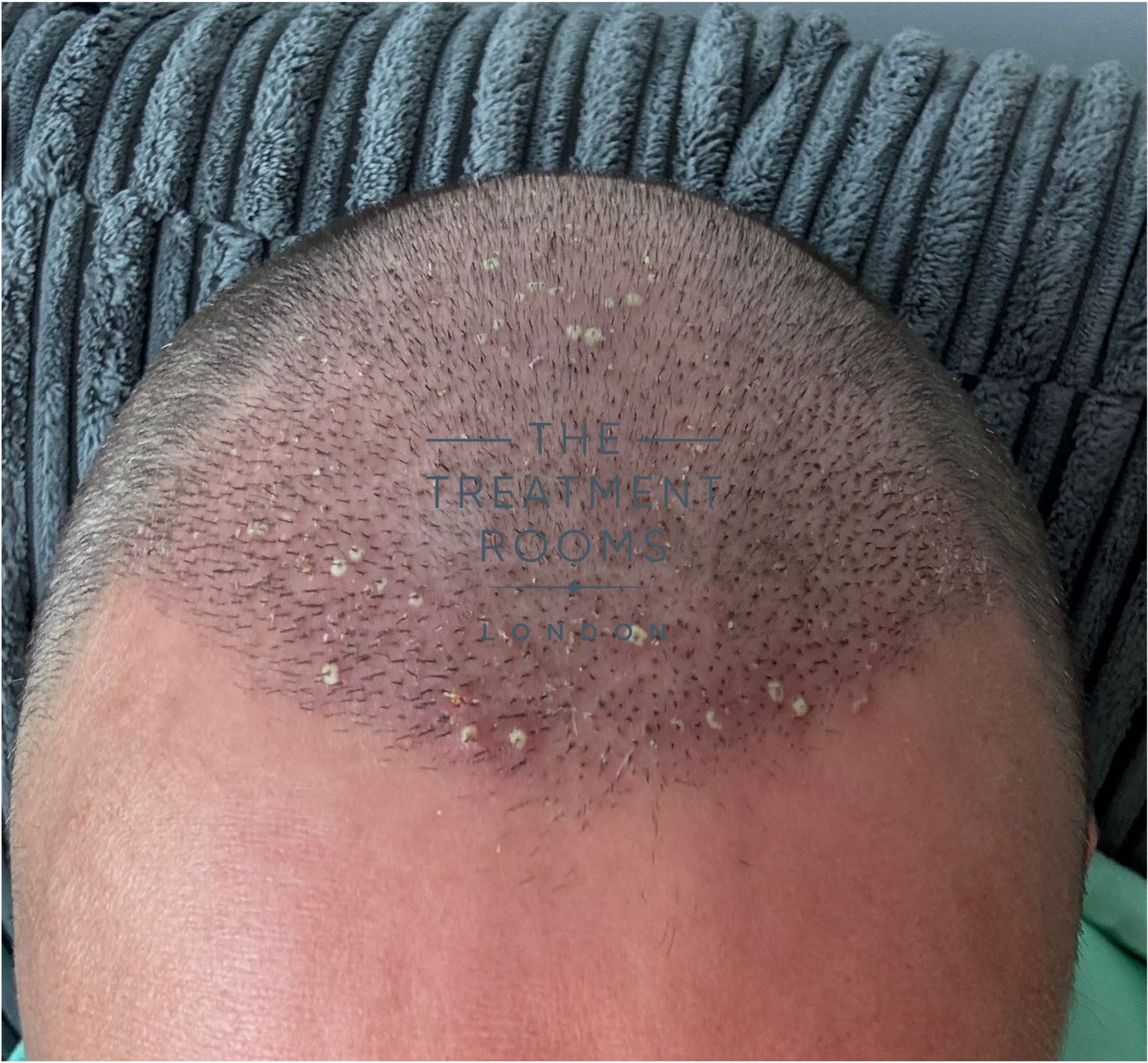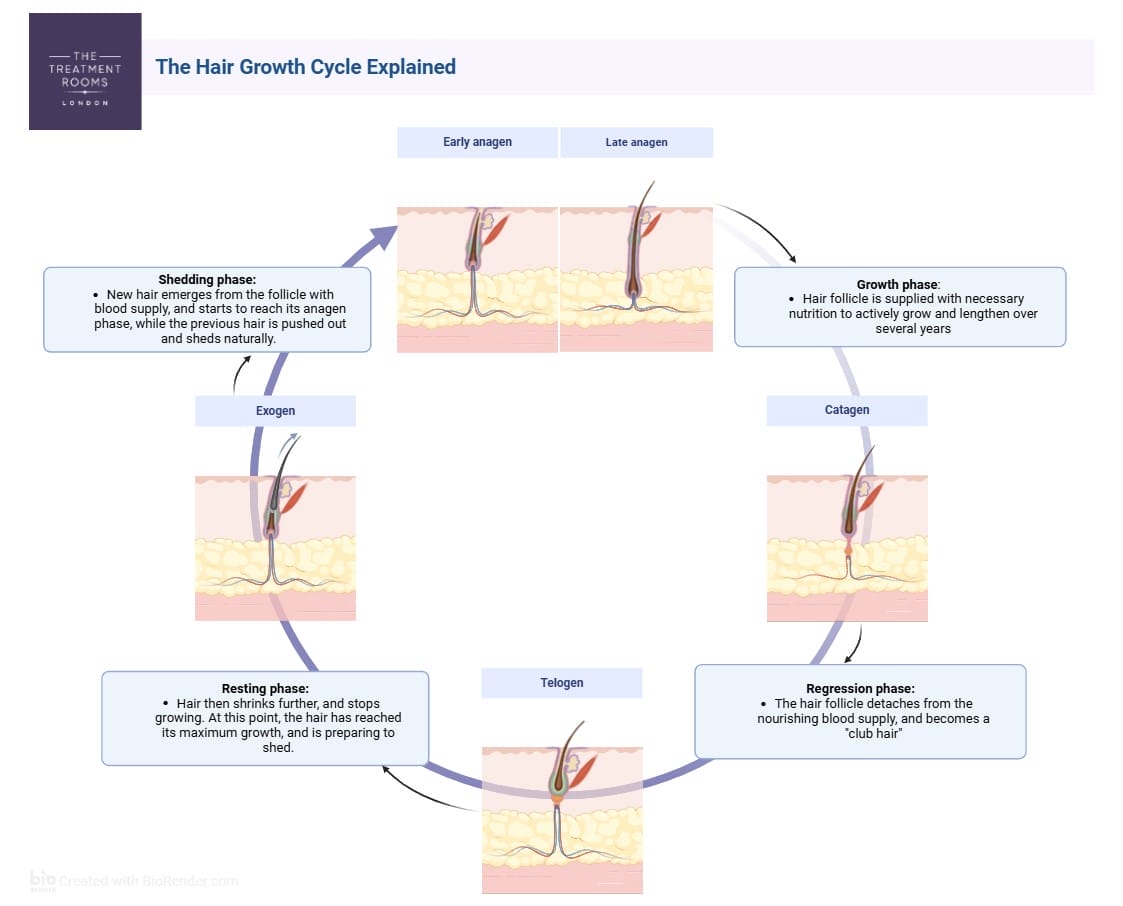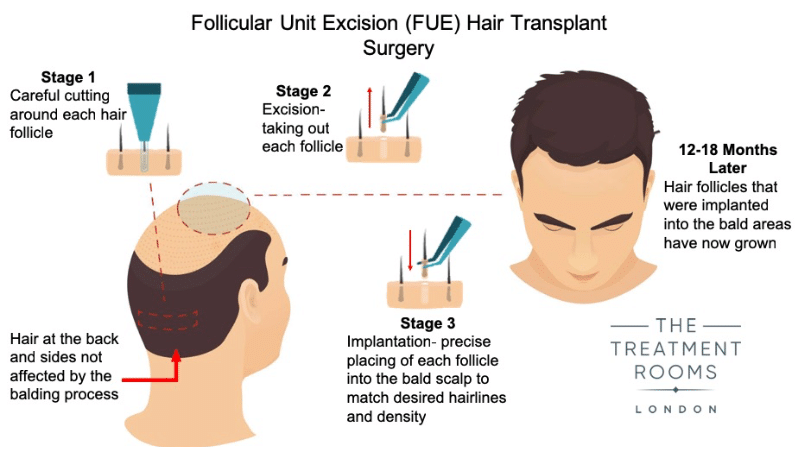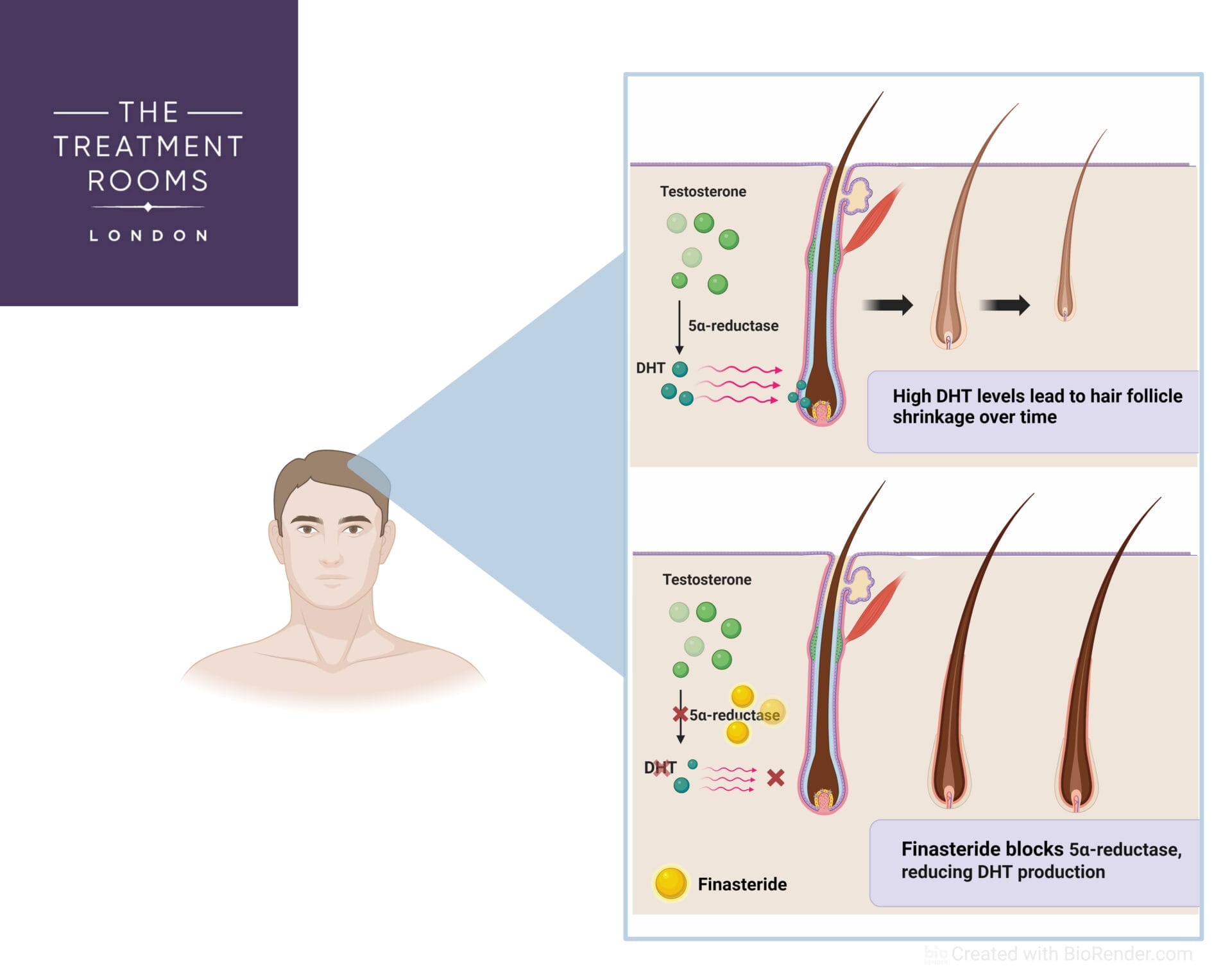Quick Summary: Folliculitis and Hair Loss
- What is Folliculitis? Folliculitis is a condition characterised by inflammation of the hair follicles. It is caused by bacterial, fungal, or viral infections, often appearing as red or pus-filled bumps. It can affect any area with hair, including the scalp.
- What Causes Folliculitis: Folliculitis can be triggered by bacterial infections, such as Staphylococcus aureus, fungal infections, or mechanical irritation. Some forms, such as folliculitis decalvans, are more likely to result in hair loss.
- What are the Symptoms of Folliculitis: Symptoms include small, red bumps, pustules, itching, and tenderness. In severe cases, folliculitis can cause scarring and hair loss.
- How Folliculitis Affects Hair Loss: Chronic or severe folliculitis, particularly folliculitis decalvans, can lead to permanent hair loss due to scarring of the follicles.
- What Treatment Options are available for Folliculitis: Treatment varies depending on the cause of folliculitis, and may include antibiotics, antifungals, antivirals, and corticosteroids. Medications like minoxidil or finasteride can help promote hair regrowth in cases of hair loss.
- Conclusion: Early intervention is crucial in preventing folliculitis from causing long-term damage and hair loss, particularly in severe forms such as folliculitis decalvans.
Do you often find yourself scratching your head? Have you noticed red bumps appearing on your scalp? Among the many possible causes, one common condition could be folliculitis. In this blog, we’ll delve into everything you need to know about folliculitis, from its causes and symptoms to effective treatments.
What is Folliculitis?
Folliculitis is the inflammation of hair follicles, small organs embedded in the skin that produce hair strands. This condition can result from bacterial, fungal, or viral infections, mechanical irritation, or blockages1. It often appears as small, red, or pus-filled bumps surrounding hair, resembling acne. While folliculitis can occur anywhere on the body with hair, common sites include the scalp, neck, arms, and thighs, particularly in areas prone to friction or sweating.

What Are the Causes of Folliculitis?
Folliculitis is most commonly triggered by a bacterial infection affecting the superficial or deep hair follicles. However, it can also result from fungi, viruses, or even noninfectious factors. Below are some of the main causative agents associated with folliculitis:
- Superficial Bacterial Folliculitis: Caused by a bacterial species called Staphylococcus aureus, including both methicillin-sensitive and methicillin-resistant strains2.
- Gram-Negative Bacterial Folliculitis: Often due to Pseudomonas aeruginosa (“hot tub folliculitis”)3 or bacteria like Klebsiella and Enterobacter, typically after antibiotic use or exposure to contaminated water4.
- Pityrosporum Folliculitis: Fungal folliculitis caused by Malassezia species, common in adolescents with oily skin5.
- Viral Folliculitis: Most often caused by the herpes virus, presenting in clusters as papulovesicles or plaques6.
- Eosinophilic Folliculitis: Occurs mainly in advanced HIV patients or as a rare chemotherapy side effect, presenting as itchy red papules7.
Some forms of folliculitis are more likely to contribute to hair loss than others. For instance, gram-negative folliculitis typically affects areas like the nose and mouth, making scalp hair loss unlikely. In contrast, superficial bacterial folliculitis can develop anywhere on the body, including the scalp, and may lead to scarring and hair loss if left untreated.
It is common for patients with itchy scalps to be more prone to folliculitis. The reason being that when you scratch the skin you break the protective skin barrier, making it easier for bacteria to enter.

Symptoms of Folliculitis
Folliculitis symptoms can range from mild to severe and often include:
- Small red or white bumps centred around hair follicles.
- Pustules that may ooze or form crusts in severe cases.
- Itching, tenderness, or a burning sensation.
Left untreated, severe folliculitis can lead to complications, including scarring, hyperpigmentation, and secondary bacterial infections.
Folliculitis and Hair Loss
While mild cases of folliculitis generally do not result in hair loss, more severe or chronic forms can lead to damage. Repeated inflammation can damage the structure of hair follicles, potentially causing scarring that prevents new hair growth and leads to permanent hair loss in affected areas.
Specific forms of folliculitis, particularly folliculitis decalvans, can lead to permanent hair loss8. This severe and chronic condition primarily affects the scalp, causing intense inflammation and scarring of the hair follicles. As the follicles become damaged, they can no longer support hair growth, resulting in permanent hair loss in the affected areas.
The exact cause of folliculitis decalvans is unknown, but it is believed to result from an infection caused by Staphylococcus aureus. In folliculitis decalvans, the scarring process is progressive, which can lead to widespread hair thinning or complete bald patches over time if left unmanaged. Early intervention and treatment are crucial to prevent long-term follicular damage and hair loss.
Treatments for Folliculitis
The treatment for folliculitis varies depending on its cause. Bacterial folliculitis is commonly treated with topical or oral antibiotics, while viral folliculitis may require antivirals such as aciclovir or valaciclovir. Fungal folliculitis is managed with antifungal shampoos or creams, and eosinophilic folliculitis often requires corticosteroids, although it can sometimes resolve on its own1.
These treatments are generally not available over-the-counter; therefore, it is essential to consult a healthcare professional before starting any regimen.
For scalp folliculitis due to folliculitis decalvans, treatment typically involves long-term antibiotics and other medications. However, no specific licensed treatment exists for this condition. The following treatment options have been explored.
- Long-term courses of antibiotics
- Steroid injections to reduce inflammation
- Oral steroids for severe outbreaks
- Isotretinoin for severe or persistent cases
- Immune-based therapies, such as adalimumab, infliximab, tofacitinib, and baricitinib
In cases where hair loss is significant, additional treatments such as minoxidil or finasteride may be recommended to promote hair regrowth.
These medications can help manage hair loss, although they should be used under the guidance of a healthcare professional to ensure they are suitable for your condition. At The Treatment Rooms London, we would be happy to advise on routines that may benefit you in managing folliculitis, particularly if this distressing condition is causing you to experience hair loss.
Conclusion
Folliculitis is a common condition that can affect hair follicles, causing inflammation, irritation, and, in some cases, hair loss. While most cases are mild and treatable, specific forms, such as folliculitis decalvans, can cause permanent damage and scarring of the hair follicles, leading to long-term hair loss. Early diagnosis and appropriate treatment are crucial for preventing complications and maintaining healthy hair growth.
If you experience symptoms of folliculitis, particularly on the scalp, it’s essential to consult a healthcare professional to determine the underlying cause and receive targeted treatment. With the right approach, managing folliculitis and mitigating hair loss is possible, thereby ensuring optimal outcomes for both scalp health and hair preservation.
Get in Touch
Ready to elevate your hair restoration journey? Book a free consultation call with our London-based FUE hair transplant clinic. If you are based in Brighton, you can reach out to our FUE hair transplant clinic in Brighton; we also offer consultations for Oxford and Bristol.
Our award-winning team, including leading London hair transplant surgeons Dr Fernando and Dr Vara, is here to support you every step of the way.
References
- Luelmo-Aguilar J, Santandreu MS. Folliculitis: recognition and management. Am J Clin Dermatol. 2004;5(5):301-10. Available at: https://pubmed.ncbi.nlm.nih.gov/15554731/
- Chiller K, Selkin BA, Murakawa GJ. Skin microflora and bacterial infections of the skin. J Investig Dermatol Symp Proc. 2001 Dec;6(3):170-4. Available at: https://pubmed.ncbi.nlm.nih.gov/11924823/
- Bhatia A, Brodell RT. ‘Hot tub folliculitis’. Test the waters–and the patient–for Pseudomonas. Postgrad Med. 1999 Oct 1;106(4):43-6. Available at: https://pubmed.ncbi.nlm.nih.gov/10533506/
- Neubert U, Jansen T, Plewig G. Bacteriologic and immunologic aspects of gram-negative folliculitis: a study of 46 patients. Int J Dermatol. 1999 Apr;38(4):270-4. Available at: https://pubmed.ncbi.nlm.nih.gov/10321942/
- Suzuki C, Hase M, Shimoyama H, Sei Y. Treatment Outcomes for Malassezia Folliculitis in theDermatology Department of a University Hospital in Japan. Med Mycol J. 2016;57(3):E63-6. Available at: https://pubmed.ncbi.nlm.nih.gov/27581777/
- Jang KA, Kim SH, Choi JH, Sung KJ, Moon KC, Koh JK. Viral folliculitis on the face. Br J Dermatol. 2000 Mar;142(3):555-9. Available at: https://pubmed.ncbi.nlm.nih.gov/10735972/
- Laing ME, Laing TA, Mulligan NJ, Keane FM. Eosinophilic pustular folliculitis induced by chemotherapy. J Am Acad Dermatol. 2006 Apr;54(4):729-30. Available at: https://pubmed.ncbi.nlm.nih.gov/16546603/
- Otberg N, Kang H, Alzolibani AA, Shapiro J. Folliculitis decalvans. Dermatol Ther. 2008 Jul-Aug;21(4):238-44. Available at: https://pubmed.ncbi.nlm.nih.gov/18715292/#:~:text=Folliculitis%20decalvans%20is%20classified%20as%20primary%20neutrophilic%20cicatricial,in%20the%20development%20of%20this%20disfiguring%20scalp%20disease.
- British Association of Dermatologists (2012). Available at: https://www.bad.org.uk/pils/folliculitis-decalvans/
Share:
Authored by
Reviewed by
Book a Consultation
Related Blogs
What Happens If You Stop Using Minoxidil
November 2, 2025
If you’ve been consistently applying minoxidil to support your hair growth, have you ever wondered what happens…
Unlocking the Secrets of Anagen Follicles
October 23, 2025
Have you ever glanced at a mirror and wondered why some of your hair grows fast and…
Does Finasteride Cause Erectile Dysfunction?
October 22, 2025
Finasteride is one of the most promising medicines against male pattern baldness and benign prostatic hyperplasia (BPH)….
Zinc Supplements After Hair Transplant Surgery: What You Need to Know
October 7, 2025
Zinc is an essential nutrient in wound healing, tissue repair, and the healthy development of hair follicles….
What to Eat After a Hair Transplant: Essential Nutritional Guide
October 5, 2025
After the stress, needles, and surgeries, food becomes more than nourishment. A warm bite, a familiar flavour,…
Hair Loss Treatment That Works: A Complete Guide for 2025
October 3, 2025
Millions of men, women, and teenagers have hair loss problems. In 2025, hair restoration is going through…
What is an FUE Hair Transplant?: A Comprehensive Guide to Procedure, Recovery, and Results
October 3, 2025
Hair transplant surgery has gained popularity over the years, with more people now comfortable taking care of…
Does Omega-3 Deficiency Cause Hair Loss? Evidence, Mechanisms & Nutrition Guide
September 16, 2025
Omega is an essential fatty acid required for a healthy body, skin and scalp. Modern-day diets are…
When Can You Use Nizoral After a Hair Transplant?
September 12, 2025
Nizoral is a medicated shampoo that contains the antifungal drug ketoconazole. This shampoo acts against fungal infections…










